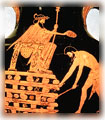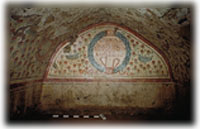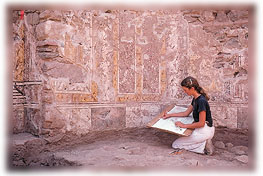
50,000-1200 b.c.e. - Prehistoric Era
 Gold earplugs from male burial ©Archaeological Exploration of Sardis/Harvard University
Gold earplugs from male burial ©Archaeological Exploration of Sardis/Harvard University |
50,000 Earliest evidence of human activity in Hermus plain.
2900-2400 Oldest burials in Hermus plain, along shores of Gygean Lake.
1300-1100 Wattle-and-daub hut and cremation burial attest to modest community at foot of acropolis.
|
|
1200-547 b.c.e. Lydian Era
 Croesus on the pyre, from a later Greek vase found in Italy. © GALLIMARD-LA PHOTOTHEQUE
Croesus on the pyre, from a later Greek vase found in Italy. © GALLIMARD-LA PHOTOTHEQUE |
ca. 1185 "Sons of Heracles" found new dynasty at Sardis, according to Herodotus.
900-725 Foreign contacts increase.
ca. 725 Apparent raid leaves burnt houses and unburied skeletons.
ca. 680-645 Gyges founds new dynasty. Discovery of gold leads to great economic prosperity and international prestige. Sophistocated art and architecture; construction of tumuli begins at Bin Tepe.
 Punch bowl (lebes), ca. 550 b.c.e. ©Archaeological Exploration of Sardis/Harvard University
Punch bowl (lebes), ca. 550 b.c.e. ©Archaeological Exploration of Sardis/Harvard University |
ca. 645-561 Reigns of Ardys, Sadyattes, and Alyattes. Invention of coinage; massive city defenses begun.
561-547 Reign of Croesus. Gold refinery; bimetallic (gold and silver) monetary standard established. Empire extends from Aegean Sea to central Anatolia. Overthrow of Croesus and sack of Sardis by Cyrus of Persia. Sardis becomes a provincial capital of the Persian empire.
|
|
547-334 b.c.e. - Persian Era
499 Greek raid and burning of Sardis leads to war between Greeks and Persians.
5th century Greek historian Herodotus writes about Sardis.
|
|
334-133 b.c.e. - Hellenistic Era
334-213 Alexander the Great takes Sardis; his successors battle among themselves for control. Artemis temple begun; early theater, gymnasium, and stadium built.
213-188 Antiochus III of the Seleucid dynasty captures Sardis, causing much destruction; makes reparations.
188-133 Kings of Pergamum control Sardis until Attalus III bequeaths kingdom to Rome.
|
|
133 b.c.e.-400 c.e. - Roman Era
 Subterranean tomb with painted decoration, built for Chrysanthios and his family, 340-400 c.e. ©Archaeological Exploration of Sardis/Harvard University
Subterranean tomb with painted decoration, built for Chrysanthios and his family, 340-400 c.e. ©Archaeological Exploration of Sardis/Harvard University |
46-28 Julius Caesar and Augustus decree that Jews at Sardis have a right to assemble according to "custom of their forefathers."
17 Earthquake causes great destruction. Emperor Tiberius remits taxes and offers substantial funds for rebuilding.
ca. 90 Sardis, one of Seven Churches of Asia, addressed in the Revelation of Saint John.
211 Bath-gymnasium complex largely completed.
320-360 Synagogue takes final form; Church EA and circuit wall of city built.
|
|
400-ca. 1315 c.e. - Late Roman-Byzantine Era
400-575 Urban revival. Townhouses and villas; shops along south side of synagogue; Christian chapel at Artemis temple.
 Fresco in fifth-century townhouse ©Archaeological Exploration of Sardis/Harvard University
Fresco in fifth-century townhouse ©Archaeological Exploration of Sardis/Harvard University |
575-early 7th century Slow economic decline, perhaps hastened by Sassanian raids in Asia Minor (611-626). Much architecture damaged and not repaired.
ca. 650 Fortress erected on acropolis, using spoils from city.
716-799 Frequent Arab raids in Lydia.
ca. 1230 Church E built over ruins of Church EA.
|
|
ca. 1315 c.e.-present - Turkish Era
 "Golden Horn"-style bowl, ca. 1500 ©Archaeological Exploration of Sardis/Harvard University
"Golden Horn"-style bowl, ca. 1500 ©Archaeological Exploration of Sardis/Harvard University |
ca. 1315 Sardis falls to Turks.
1402 Tamerlane sends expeditionary force to attack Sardis; city probably pays ransom for its freedom.
ca. 1425 Fortress on acropolis abandoned but village at foot continues to flourish.
|
|